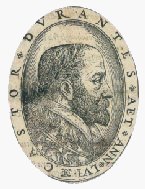Castore Durante on:
[Wikipedia]
[Google]
[Amazon]
 Castore Durante, also called Castor Durante da Gualdo (
Castore Durante, also called Castor Durante da Gualdo (AstiLibri: Brief biography
/ref> His father was the jurist Giovan Diletto Durante. He had five siblings, including a brother named Pollùce (Pollux). He graduated in medicine at
Digital edition from 1602
by the
Enciclopedia Treccani: Detailed biography and bibliography
{{DEFAULTSORT:Durante, Castore 1529 births 1590 deaths Scientists from the Papal States People from Gualdo Tadino 16th-century Italian botanists 16th-century Italian physicians Herbalists
 Castore Durante, also called Castor Durante da Gualdo (
Castore Durante, also called Castor Durante da Gualdo (Gualdo Tadino
Gualdo Tadino (Latin: ''Tadinum'') is an ancient town of Italy, in the province of Perugia in northeastern Umbria, on the lower flanks of Monte Penna, a mountain of the Apennines. It is NE of Perugia.
History
Gualdo has a long history and was o ...
, 1529 – Viterbo
Viterbo (; Central Italian, Viterbese: ; ) is a city and ''comune'' (municipality) in the Lazio region of Italy, the Capital city, capital of the province of Viterbo.
It conquered and absorbed the neighboring town of Ferento (see Ferentium) in ...
, 1590) was a physician, botanist and poet of the Italian Renaissance
The Italian Renaissance ( ) was a period in History of Italy, Italian history between the 14th and 16th centuries. The period is known for the initial development of the broader Renaissance culture that spread across Western Europe and marked t ...
./ref> His father was the jurist Giovan Diletto Durante. He had five siblings, including a brother named Pollùce (Pollux). He graduated in medicine at
Perugia
Perugia ( , ; ; ) is the capital city of Umbria in central Italy, crossed by the River Tiber. The city is located about north of Rome and southeast of Florence. It covers a high hilltop and part of the valleys around the area. It has 162,467 ...
in 1567 and practiced as a doctor in Gualdo Tadino. He later taught at the "Archiginnasio della Sapienza" (now called the Sapienza University of Rome
The Sapienza University of Rome (), formally the Università degli Studi di Roma "La Sapienza", abbreviated simply as Sapienza ('Wisdom'), is a Public university, public research university located in Rome, Italy. It was founded in 1303 and is ...
) and, on the recommendation of Cardinal Girolamo Rusticucci
Girolamo Rusticucci (1537 – 14 June 1603) was an Italian Roman Catholic cardinal and bishop. He was personal secretary to Cardinal Michele Ghislieri, later Pope Pius V, who made Rusticucci a cardinal. He occupied numerous important positions, i ...
, was appointed chief physician at the court of Pope Sixtus V
Pope Sixtus V (; 13 December 1521 – 27 August 1590), born Felice Piergentile, was head of the Catholic Church and ruler of the Papal States from 24 April 1585 to his death, in August 1590. As a youth, he joined the Franciscan order, where h ...
.
He died at Viterbo
Viterbo (; Central Italian, Viterbese: ; ) is a city and ''comune'' (municipality) in the Lazio region of Italy, the Capital city, capital of the province of Viterbo.
It conquered and absorbed the neighboring town of Ferento (see Ferentium) in ...
in 1590 and was buried in the church of the Franciscan
The Franciscans are a group of related organizations in the Catholic Church, founded or inspired by the Italian saint Francis of Assisi. They include three independent Religious institute, religious orders for men (the Order of Friars Minor bei ...
monastery.
Major works
*''Herbario Nuovo'', published in 1585, is a description ofmedicinal plant
Medicinal plants, also called medicinal herbs, have been discovered and used in traditional medicine practices since prehistoric times. Plants synthesize hundreds of chemical compounds for various functions, including Plant defense against h ...
s from Europe and the Indies (East and West). The first editions were illustrated by Leonardo Parasole
Leonardo Parasole (c. 1570–1612) was an Italian engraver on wood of the late-Mannerist and early-Baroque periods.
He was born and remained in Rome throughout his life. Parasole designed cuts for the Herbal book written by Castore Durante, phy ...
da Norcia (fl.1570), while the third edition contains woodcuts by his wife, the engraver Isabella Parasole
Isabella Parasole (ca. 1570 – ca. 1620) was an Italian engraver and woodcutter of the late-Mannerist and early-Baroque periods also known as Isabella Catanea Parasole and Isabetta Catanea Parasole.
She was active in Rome in the late sixteenth a ...
. Each species includes discussions of its habitat and medicinal uses, in both Italian and Latin. It went through eleven editions in Italian, German and Spanish. Reprints appeared occasionally for over 130 years.Digital edition from 1602
by the
University and State Library Düsseldorf
The University and State Library Düsseldorf (, abbreviated ULB Düsseldorf) is a central service institution of Heinrich Heine University. Along with Bonn and Münster, it is also one of the three State Libraries of North Rhine-Westphalia.
...
)
*''Il Tesoro della Sanità'', published in 1586, is a collection of folk-medicine remedies for the family, with practical rules for hygiene and dietary suggestions. In 1686 it was translated into English by John Chamberlayne
John Chamberlayne (c.1668–1723) was an English writer, translator, and courtier.
Life
He was a younger son of Edward Chamberlayne and his wife Susannah Clifford. In 1685 he entered Trinity College, Oxford as a commoner.
Leaving Oxford without ...
.
References
External links
Enciclopedia Treccani: Detailed biography and bibliography
{{DEFAULTSORT:Durante, Castore 1529 births 1590 deaths Scientists from the Papal States People from Gualdo Tadino 16th-century Italian botanists 16th-century Italian physicians Herbalists